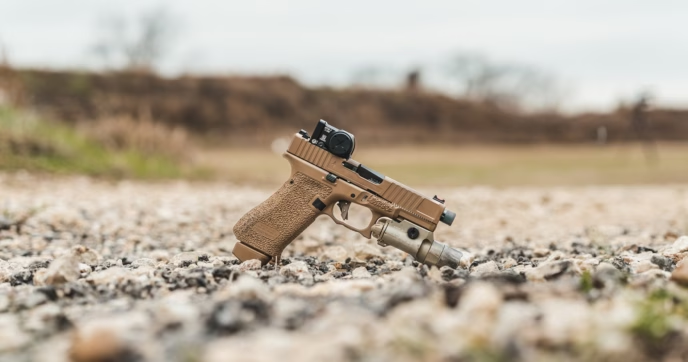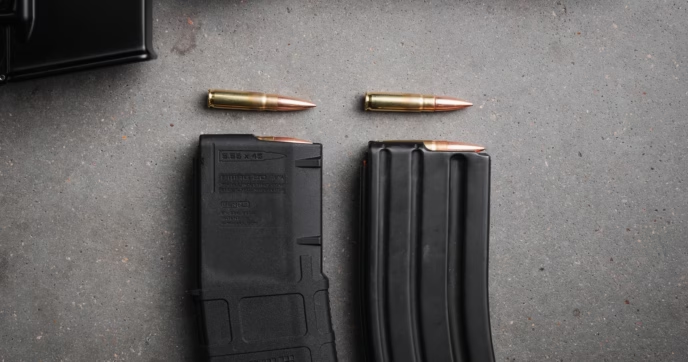The AR-10, is a robust platform that’s easily adaptable to suit an array of applications. If you aren’t already familiar with it, it’s essentially the AR-15’s big brother, capable of chambering large-rifle caliber rounds, making it extremely popular for long range applications.
Since these rifles can be built from readily available parts, it’s common for enthusiasts to build an AR-10 rather than buy one. Especially since AR-10 rifles offer a degree of variety and flexibility that’s comparable to the AR-15.
As a result, there are dozens upon dozens of manufacturers producing components for these rifles. But at the same time, there are many options for factory-built AR-10s, with some being optimized for specific purposes.
So that begs the question: Is it better to build, or to buy?

Understanding the AR-10
Before we delve into whether it’s better to build or buy an AR-10, it’s important to understand the rifle itself. As we mentioned before, the AR-10 is essentially a larger AR-15. Whereas the AR-15 is commonly chambered in 5.56 NATO/.223 Remington, the AR-10 calibers are larger. Most often, they’re chambered in either 7.62 NATO/.308 Winchester or 6.5 Creedmoor.
Being able to utilize larger calibers, they’re commonly used for long range applications and scenarios where extra ballistic power is warranted, like hunting for example. The manual of arms is similar to the AR-15’s, as the control layout is nearly identical, albeit with some variance in control spacing. In fact, many AR-10 and AR-15 parts are interchangeable.
The adaptability of the AR-10 is almost on-par with the AR-15. Manufacturers commonly produce them in different configurations, such as PRS and DMR styles, to better suit different applications. For instance, Daniel Defense, SIG Sauer, Seekins Precision, and LaRue Tactical are just a few examples of premium brands which are renowned amongst enthusiasts for producing high-quality rifles as well as specialized upper receivers.
Seekins Precision and LaRue Tactical specialize in crafting rifles that provide sub-MOA accuracy out of the box. Other brands, such as Daniel Defense and SIG Sauer, offer comparable rifles, but have a greater range of options that come in more standard configurations while still using high-quality components.
Among the mentioned brands, Daniel Defense AR-10s are some of the most popular AR-10s available. Our article about Daniel Defense’s quality and performance highlights their AR-10s and other products.
AR-10 vs. Other Rifles
Though other .308 rifles share similarities with the AR-10, it stands out in a few ways. Many similar rifle platforms use a gas piston system to cycle the action, while the AR-10 uses a direct impingement system. With piston-driven rifles, there is a lot of rapid movement above the barrel which negatively affects their barrel’s harmonics. The extra movement of the barrel can cause slight deviations in shot placement, which becomes more noticeable when shooting at great distances. The harmonics of DI rifles tend to be much better, since there isn’t a piston to move, and they often come with free floated barrels.
This isn’t to say that piston guns are inaccurate, but at longer distances, the AR-10 is often much more precise and lighter than other rifles in its class. Though the weight depends heavily on the configuration of the rifle, in some cases, an AR-10 can be several ounces to a pound lighter than other rifle variants.
It’s important to note that not all AR-10s are the same. Different manufacturers use their own designs, with some models being lighter and more agile than others, while others are optimized for precision shooting. The beauty of the AR-10 is that it can be tailored to fit your exact needs, which is part of what makes it such a popular rifle.
Something else to note is that the term ‘AR-10’ does not account for all AR pattern rifles chambered in .308. In fact, it’s a trademark for Armalite’s rifle. While other rifles may be called ‘AR-10s’ they likely use other design patterns such as the LR-308, SR-25, and DPMS pattern AR style rifles. Our guide on AR-10s vs. LR-308s goes more in depth on this, and we’ll touch on the different rifle patterns further below as well.
Building vs. Buying: Which is the Right Choice?
When it comes to building or buying an AR-10, it can be difficult to choose which to do since both options can net you an excellent rifle. That said, both methods have their own pros and cons that need to be considered before making a choice:

Pros and Cons: Building an AR-10
One of the immediate pros of building an AR-10 over buying one is the amount of customizability you have. The AR-10 boasts a vast aftermarket with access to a wide array of parts and components, allowing you to choose precisely which ones you want on your rifle. There are countless brands offering cost-effective parts for those on a budget, and premium ones for those looking for enhanced components like lower parts and AR-10 buffer tube kits.
While building an AR is a solid choice, it takes considerable time and effort to do so. If you don’t know how to build an AR-10, the learning curve can be steep. Also, you’ll need specific tools to do the job. While it’s not impossible to build a rifle with household tools, they don’t offer the same degree of precision offered by dedicated AR tools. By not using them, you increase your risk of marring the finish of parts, or worse, damaging the receiver and components.
Building a rifle also comes with a lack of professional quality control. When made by a manufacturer, rifles often come with some sort of factory guarantee. When you build your own rifle, you are fully responsible for the level of care put into building the rifle. Though this seems daunting, if you take your time to make sure everything is secure and properly in place, you’ll be good to go.
If you aren’t interested in building a rifle part by part, you can always use complete receivers. Complete lower receivers come equipped with all of their necessary components. The same applies for the upper receiver too. While the lower houses the main controls of the rifle, the upper is arguably what determines the rifle’s purpose. Many complete AR-10 uppers are available with varying barrel lengths and handguards, but remember, assembling one from upper parts allows you to optimize it how you deem fit.
Another important thing to note is that not all AR-10 components are compatible with each other. Unlike the AR-15, AR-10s have multiple patterns since there isn’t a true mil-spec AR-10 derivative. For instance, some of the most popular AR-10 patterns are the Armalite, DPMS, and SR-25 patterns. Of the three, the Armalite and DPMS patterns are the most common. Regardless, they each need to be paired with their corresponding receiver (DPMS with DPMS and Armalite with Armalite). If you start a new AR-10 build, double-check to ensure all your parts are compatible with each other.

Pros and Cons: Buying an AR-10
Buying an AR-10 is never a bad choice, especially since there are so many brands making high-quality rifles that are ready to use out of the box. Still, buying a rifle has its pros and cons too.
Arguably, the biggest advantage that comes with buying a rifle is convenience. If you’re interested in an AR-10, buying one off the shelf is the simplest and easiest way to get one, with the main ‘challenge’ being choosing which model to go with. There are a ton of different rifles available designed to cater to diverse needs.
For instance, if your rifle’s purpose is going to be for recreation or hunting at close to medium ranges, a standard AR-10 will get the job done. If you’re interested in long range shooting, you’d want to opt or something like a PRS (Precision Rifle Series) or a DMR configuration.
Though there are many options to choose from, you won’t have nearly the degree of flexibility in terms of opting for specific parts. Unlike building an AR-10, which gives you full control of the parts used, buying one limits you to what the manufacturer includes with the rifle. Although most AR-10s come with modern comforts you’d expect to find on rifles today, not all do. While they can be upgraded with relative ease, aftermarket parts can be quite expensive, and like we said before, complete rifles vary drastically in price. So, if you have something specific in mind, you’re better off building instead of buying.

Cost Considerations
There’s a common belief that it’s more cost-effective to build an AR-10 than to buy one. While it isn’t entirely wrong, it’s only true to a certain extent. Individual parts are priced based on the material they’re made of, enhancements, and brand. For example, a standard AR-10 lower parts kit can cost as little as $50, while an upgraded kit can cost much more. A straightforward way to think of it like this: premium parts come with premium prices.
Building an AR-10 can cost around $500 to $700 when you’re looking for deals on parts. While it is more than possible to build a rifle on a budget, depending on the parts you use, building a rifle can cost well over $1,000+, or depending on the components, more than a premium off the shelf AR-10. Remember though, this rifle will have the parts of your choice while a bought rifle wouldn’t.
In terms of buying a rifle, complete AR-10s vary in price depending on the manufacturer and parts quality; many standard AR-10 models can be priced anywhere from $700 to $1,200+, while premium rifles can cost over $1,500+, with some being well over $2,500+. There are a lot of rifles available though, making it less of a struggle to find a model that fits your budget and needs.
So, is it Better to Build or Buy?
With the various pros and cons of building and buying laid out above, the question remains: is it better to build or buy? The answer ultimately depends on your specific needs.
Building an AR-10 is the best option if you want full control over your build. Doing so opens the possibility of creating a rifle optimized for whatever you want. You can easily build a rifle that’s tailored for long distance precision shooting, or if that’s not your style, you can opt for a more agile rifle for a faster style of shooting.
On the other hand, buying a rifle is much quicker and more convenient than building one. While there isn’t extra work involved like with building, you won’t have as much flexibility for adding specific components, unless you upgrade later. Still, each rifle is built to the manufacturer’s specifications and comes with their factory guarantee. Though it’s unlikely that something would go wrong with your rifle, having the extra assurance is a nice bonus.

Conclusion
At the end of the day, building or buying an AR-10 comes down to your personal preference and experience. Though building an AR-10 gives you the greatest amount of flexibility, it can pose a challenge to those who are unfamiliar with the platform. In contrast, buying is a much quicker and easier alternative, just keep in mind that you won’t have as much flexibility in choosing the parts that come equipped on it.
No matter whether you opt to build or buy, it’s important to research each option to make sure the parts or rifle you choose are made by reputable manufacturers. Likewise, it’s always a good idea to consider your needs before making a purchase. So long as you’ve taken the time to do so, you’ll have a solid rifle when it’s all said and done.
Once you have the AR-10 build of your choice, you’ll need a good optic to pair with it. Check out our guide on choosing the best optic for 6.5 Creedmoor rifles. It goes over everything to consider before adding investing in an optic.





